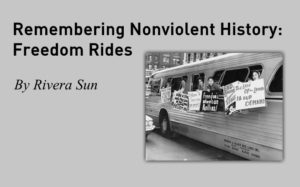 By May 1961, federal law had already ruled that segregation on interstate, public buses was illegal. Southern states, however, maintained segregation in seating, and at bus station bathrooms, waiting rooms and drinking fountains. The Interstate Commerce Commission refused to take action to enforce federal law. To change this, the Civil Rights Movement (CORE, SNCC, NAACP) began a series of Freedom Rides on May 4th, 1961, 55 years ago. By the end of the campaign, 436 individuals had participated in at least 60 separate Freedom Rides, ultimately forcing the Interstate Commerce Commission to enforce federal law and desegregate interstate bus services.
By May 1961, federal law had already ruled that segregation on interstate, public buses was illegal. Southern states, however, maintained segregation in seating, and at bus station bathrooms, waiting rooms and drinking fountains. The Interstate Commerce Commission refused to take action to enforce federal law. To change this, the Civil Rights Movement (CORE, SNCC, NAACP) began a series of Freedom Rides on May 4th, 1961, 55 years ago. By the end of the campaign, 436 individuals had participated in at least 60 separate Freedom Rides, ultimately forcing the Interstate Commerce Commission to enforce federal law and desegregate interstate bus services.
The Freedom Riders drew inspiration from the Journey of Reconciliation in 1947, led by Bayard Rustin and George Houser. The Freedom Rides campaigns followed on the heels of the highly visible lunch counter sit-in campaigns that began in 1960. Diane Nash, a veteran of the Nashville, Tennessee, campaign, was one of the lead organizers of the Freedom Rides, and it was at her urging that the demonstrators persevered through the extreme violence, carrying on to success despite life-threatening situations.
The Freedom Riders’ nonviolent strategy led to careful and effective tactics, placing themselves symbolically in challenging places—black riders sitting up front, white and black sitting together—but with one rider observing Southern segregation customs in order to avoid arrest and contact CORE to arrange bail for those jailed.
Strategy, training, and discipline were essential components of preparation for the Freedom Riders. Over the four months of the campaign, they were beaten, arrested, attacked by mobs; the buses were set on fire, the KKK surrounded them and threw tear gas into the locked buses; at times, Greyhound and Trailways bus lines refused to protect or transport them; hospitals denied care and ambulances would not carry injured Freedom Riders. All Freedom Riders practiced flawless nonviolent discipline despite massive provocation.
On May 14, Mother’s Day, in Anniston, Alabama, Ku Klux Klansmen, some still in church attire, attacked the first of two buses arriving and departing from the station. The driver tried pull away, but was blocked by KKK members. The tires were slashed. A few miles outside of town, the crippled bus was forced to stop by the KKK, who firebombed it. The mob held the doors shut, intending to burn the riders to death. The riders escaped the bus, but were then severely beaten. Only warning shots fired into the air by highway patrolmen prevented the riders from being lynched. The second of the two buses arriving in Anniston, Alabama, likewise faced violent attacks, leaving Freedom Riders semi-conscious in the back of the bus.
Throughout the summer, the Freedom Riders persevered, facing violence, intimidation, and arrests. The nation was shocked by both the violence and the knowledge that southern authorities were ignoring federal laws—the fearless nonviolence of the Freedom Riders gained sympathy and respect. The Freedom Riders escalated until September, when the ICC, faced with the likelihood of more nonviolent direct action campaigns, issued new policies enforcing the desegregation of interstate buses. On November 1, 1961, when the new ICC rules took effect, passengers were permitted to sit wherever they pleased on interstate buses and trains; “white” and “colored” signs were removed from the terminals; racially segregated drinking fountains, toilets, and waiting rooms serving interstate customers were desegregated; and the lunch counters began serving all customers, regardless of race.
The Freedom Rides are a powerful example of the use of nonviolent direct action to enforce justice and fair laws. Remember, by 1961, federal law forbid segregation on interstate buses. Using nonviolent action, the Freedom Riders exercised their rights, upheld the law, and refused to cooperate with injustice.
A uthor/Activist Rivera Sun, syndicated by PeaceVoice, is the author of The Dandelion Insurrection, Billionaire Buddha and Steam Drills, Treadmills, and Shooting Stars, the cohost of Love (and Revolution) Radio, and the cofounder of the Love-In-Action Network. She is a trainer and social media coordinator for Campaign Nonviolence and Pace e Bene. Sun attended the James Lawson Institute on Strategic Nonviolent Resistance in 2014 and her essays on social justice movements appear in Truthout and Popular Resistance. www.riverasun.com
uthor/Activist Rivera Sun, syndicated by PeaceVoice, is the author of The Dandelion Insurrection, Billionaire Buddha and Steam Drills, Treadmills, and Shooting Stars, the cohost of Love (and Revolution) Radio, and the cofounder of the Love-In-Action Network. She is a trainer and social media coordinator for Campaign Nonviolence and Pace e Bene. Sun attended the James Lawson Institute on Strategic Nonviolent Resistance in 2014 and her essays on social justice movements appear in Truthout and Popular Resistance. www.riverasun.com
